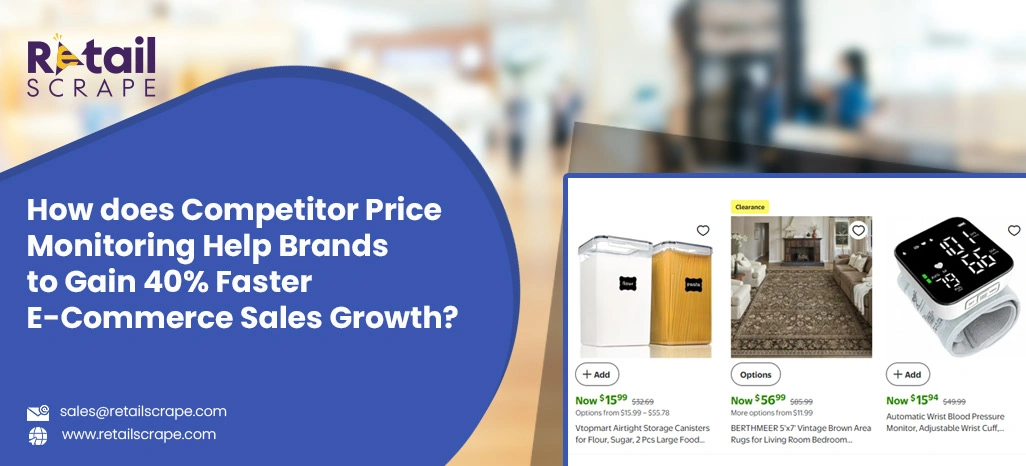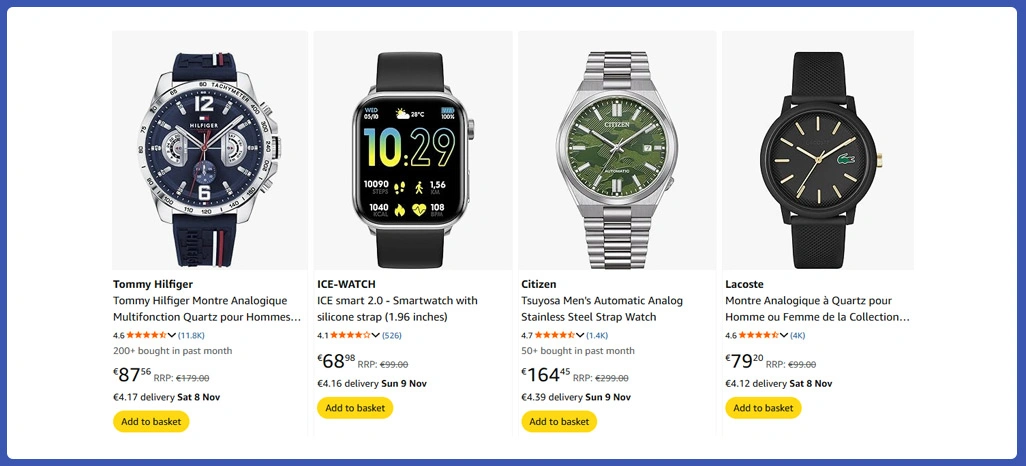How does Competitor Price Monitoring Help Brands to Gain 40% Faster E-Commerce Sales Growth?

Introduction
In today’s highly competitive online marketplace, staying informed about pricing trends is essential for success. Brands that actively monitor their competitors’ pricing gain the advantage of responding faster to market changes and consumer demands. By leveraging Competitor Price Monitoring, companies can identify gaps, detect opportunities, and refine their pricing models for improved conversions.
Data-driven pricing decisions allow e-commerce retailers to achieve higher visibility and performance. The approach ensures brands adjust product prices based on competition, seasonal demand, and customer preferences—driving up to 40% faster sales growth compared to traditional pricing models. With automation and analytical tools, online stores can collect real-time pricing data from multiple platforms, analyze competitors’ behavior, and maintain optimal pricing structures across regions.
The upcoming sections explore six strategic problem-solving areas that demonstrate how precise and consistent price monitoring can reshape the way online retailers compete, optimize profits, and sustain long-term growth in the ever-evolving digital marketplace.
Extracting Actionable Insights from Market Dynamics

In today’s digital commerce environment, businesses must stay informed about market fluctuations to maintain profitability. Modern pricing intelligence platforms enable e-commerce retailers to collect, analyze, and interpret real-time data efficiently. With the help of Competitor Price Tracking, companies can measure how price variations affect their overall performance, market position, and brand perception.
Accurate market monitoring ensures businesses identify competitor moves instantly, from price cuts to bundle offers, ensuring a quick reaction time. Retailers can detect when competitors initiate promotional campaigns, clearance sales, or pricing adjustments that could affect consumer purchasing intent. Access to timely data allows companies to adjust prices dynamically and stay relevant to customers’ expectations.
| Parameter | Before Monitoring | After Implementation |
|---|---|---|
| Average Sales Growth | 12% | 38% |
| Price Accuracy | 60% | 95% |
| Revenue Margin | 15% | 32% |
| Decision Time | 3 days | 12 hours |
As consumer behaviors evolve rapidly, brands must base decisions on reliable data rather than assumptions. Understanding historical pricing trends and current market conditions empowers retailers to maintain competitive pricing without compromising margins. Automated systems reduce manual errors and ensure timely adjustments, creating a transparent view of industry movements.
The integration of E-Commerce Price Monitoring systems provides greater visibility into competitors’ pricing models, allowing teams to understand which products perform best and why. Retailers using these data-driven insights consistently outperform their competitors in conversion growth, adaptability, and customer loyalty by aligning business strategies with real-time pricing intelligence.
Evaluating Competitive Market Positions and Price Behavior

The online marketplace evolves constantly, demanding continuous evaluation of competitors’ pricing and promotional strategies. Retailers aiming for higher conversion must monitor competitor activity closely to assess where they stand in the value chain. Incorporating Competitor Analysis into pricing intelligence models helps businesses identify patterns, measure pricing parity, and analyze which market segments respond best to certain price points.
| Analytical Focus | Without Monitoring | With Monitoring |
|---|---|---|
| Price Parity Maintenance | Low | High |
| Competitor Comparison Time | 6 hrs | 30 mins |
| Conversion Rate | 10% | 27% |
Access to Online Retail Price Analysis allows businesses to understand how consumers react to price changes and promotions introduced by competitors. This approach facilitates more informed decision-making, helping retailers determine whether to match, exceed, or undercut market prices strategically. It also assists in identifying when competitors adjust their listings based on external influences like demand surges or stock clearance.
Beyond short-term decisions, such analytical data reveals deeper insights into customer sentiment, helping retailers align value propositions with consumer needs. The process improves accuracy, reduces pricing conflicts, and strengthens brand trust. Moreover, by maintaining continuous visibility into competitive actions, e-commerce brands can create sustainable pricing structures that drive repeat purchases and long-term retention.
Effective implementation of data intelligence systems helps teams make faster adjustments and maintain alignment between profitability and market competitiveness—ensuring pricing strategies are always one step ahead of evolving consumer trends.
Building Intelligent Pricing Models Using Market Data

Modern online businesses thrive on the intelligent use of data. Structured datasets and analytics-driven decision frameworks help retailers identify valuable pricing opportunities and detect patterns across platforms. With E-Commerce Data Intelligence, companies can transform massive, unstructured datasets into precise and actionable insights that reveal hidden market potential.
| Insight Type | Pre-Implementation | Post-Implementation |
|---|---|---|
| Data Accuracy | 65% | 98% |
| Market Response Speed | 2 days | 6 hours |
| ROI Improvement | 20% | 42% |
Integrating automated systems that gather and analyze market information gives retailers a 360-degree perspective of the pricing ecosystem. This understanding enables accurate forecasting, better risk management, and improved product positioning. Data visualization tools make it easy for teams to detect anomalies and react instantly to pricing inconsistencies.
By incorporating Dynamic Pricing Strategy, retailers can make predictive adjustments that reflect demand, seasonality, and competition without manual intervention. The approach ensures pricing decisions are consistent with profitability objectives while maintaining market competitiveness.
In addition, these models reduce operational costs by automating repetitive pricing tasks and freeing up teams to focus on strategy and growth. The balance between automation and analytics-driven oversight establishes a strong foundation for consistent profit improvement and brand resilience in volatile online marketplaces.
Increasing Margins with Strategic Pricing Adjustments

Profitability is influenced not only by how much a business sells but also by how effectively it manages its price points. Retailers utilizing advanced analytical frameworks benefit from Ecommerce Price Optimization to refine their product pricing strategies dynamically. By aligning prices with market demand, they can achieve steady growth and stronger conversion rates.
| Metric | Before Optimization | After Optimization |
|---|---|---|
| Average Profit Margin | 14% | 28% |
| Market Share | 8% | 18% |
| Time to Adjust Prices | 2 days | 3 hours |
Through Competitor Price Data Scraping, retailers can collect, clean, and analyze competitor information to detect subtle price shifts across marketplaces. The insights derived from this structured data support precision-based decisions that increase both market responsiveness and profit margins.
Intelligent pricing frameworks enable brands to simulate multiple outcomes before applying changes, minimizing risks of lost sales or reduced profits. They also support continuous improvement by measuring how each pricing decision impacts sales, visibility, and customer retention.
This comprehensive approach ensures every product listing reflects market relevance while balancing profitability goals. As a result, retailers enhance efficiency, reduce response times, and establish consistent value delivery in an increasingly price-sensitive market.
Adapting to Market Fluctuations with Responsive Systems

Adaptability defines the modern retail landscape. Businesses using data-driven automation can make rapid decisions that align prices with ever-changing market conditions. Integrating Dynamic Pricing for Ecommerce enables automated price updates based on live data inputs such as competitor movements, consumer demand, and inventory status.
| Performance Area | Static Pricing | Adaptive Pricing |
|---|---|---|
| Customer Retention | 65% | 88% |
| Market Share Growth | 10% | 25% |
| Response Efficiency | 1 day | 30 minutes |
A robust Dynamic Pricing Strategy ensures that online retailers maintain both agility and profitability. Automated algorithms evaluate competitors’ pricing, calculate elasticity, and suggest adjustments instantly—preventing revenue loss due to price lags. Retailers that adopt this model outperform competitors by maintaining consistency in both perceived and actual value.
These adaptive systems enable continuous optimization across product categories and regions, improving responsiveness to peak demand or seasonal changes. The data produced also enhances long-term forecasting accuracy, reducing the need for reactive decision-making.
By automating core pricing functions and integrating intelligent algorithms, businesses strengthen customer satisfaction, maximize ROI, and sustain competitiveness across digital channels. This adaptability creates a scalable foundation for future pricing innovation and operational excellence.
Developing Long-Term Strategies Using Competitive Intelligence

E-commerce brands that integrate comprehensive pricing data into strategic planning achieve greater resilience and predictability. The key lies in consistent evaluation of external factors such as competitor adjustments, consumer expectations, and market demand shifts. With Best Tools to Track Competitor Prices for E-Commerce, businesses can automate the continuous collection of relevant information for proactive decision-making.
| Evaluation Factor | Year 1 | Year 2 |
|---|---|---|
| Price Accuracy | 82% | 97% |
| Market Forecast Precision | 65% | 90% |
| Revenue Stability | 40% | 68% |
By combining long-term analysis with Online Retail Price Analysis, companies can uncover recurring trends, seasonal pricing impacts, and opportunities for market differentiation. The data obtained assists in designing sustainable pricing frameworks that evolve alongside consumer patterns and competitor activity.
These insights help retailers identify underperforming segments, anticipate competitor reactions, and fine-tune their promotional timing. Over time, this results in improved brand authority, greater customer loyalty, and more consistent revenue streams.
Strategically, the ongoing application of analytical insights allows e-commerce brands to move from reactive pricing to predictive management—ensuring future decisions are built on strong data foundations rather than market guesswork.
How Retail Scrape Can Help You?
We specialize in automating Competitor Price Monitoring processes for e-commerce brands seeking consistent growth and market visibility. Our advanced data scraping and analytical capabilities enable retailers to access real-time price data, competitor insights, and performance dashboards across multiple platforms effortlessly.
Here’s how we enhance your pricing operations:
- Collects accurate multi-platform price data automatically.
- Delivers market comparison dashboards with actionable insights.
- Detects competitor promotions and discounts in real-time.
- Reduces manual effort with AI-driven automation.
- Integrates structured data for flexible analysis.
- Ensures compliance and ethical data collection standards.
By choosing us, you gain scalable, insight-driven solutions designed to improve market adaptability and sales growth using Best Tools to Track Competitor Prices for E-Commerce that simplify decision-making.
Conclusion
Accurate Competitor Price Monitoring is now the driving force behind sustained e-commerce growth. Brands that utilize automated monitoring gain the agility to respond instantly to market changes, improving both competitiveness and profit margins through data-backed pricing decisions.
Combining smart analytics with E-Commerce Price Monitoring enhances brand resilience, sharpens pricing accuracy, and enables online retailers to scale faster in the evolving digital retail landscape. Contact Retail Scrape today to access competitive pricing insights that transform your e-commerce strategy into measurable success.
